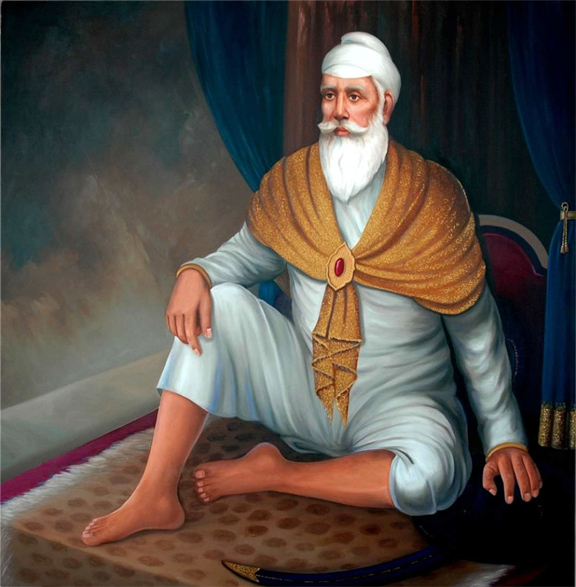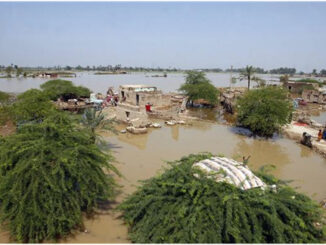4th August
1982 Gurbakash Singh tried to hijack Indian Airline plane to Lahore.
1982 Dharam Yudh morcha to seek Sikh demands was launched by Akali Dal. Additionally, the morcha initiated by Jarnail Singh Bhindrawalae, for release of Amrik Singh was also included in this.
1987 A convention was held in Amritsar. Despite risk to their lives at the hands of Indian police gangs, some Sikh leaders attanded the convention. The generals of the army of Khalistan, in this convention, confirmed their goal of total freedom from India.
Darshan Singh Ragi, chief Granthi of Sri Akal Takhat, tried to support the Hindu allies but he was snubbed by the Sikh generals. Some of his words were in complete contradiction to the Sikh fundamentals. As a result he, ipso facto, ceased to be the Granthi of Sri Akal Takhat. The Delhi regime tried to reinstate him, but the Sikh Nation with one voice, rejected the un-Sikh ideas and confirmed the goal of freedom for Khalsistan.
5th August

1992 Bhagat Puran Singh Ji, a panthic saewak who devoted his entire live in service of humankind, passed away. Bhagat Puran Singh, the legendary Saint of Amritsar. Bhagat Puran Singh died in Chandigarh on 4th August 1992. aged 88. Born Ramji Das at Rajewal, district Ludhiana, the sensitive Child, sickened by ritualism and priestly arrogance, readily embraced Sikhism with encouragement from his pious mother, Mehtab Kaur. Soon Gurbani saturated his whole being with love and compassion for all humanity, in the spirit of Guru Nanak’s exhortation Jete jiv tete sabh tere, vinn seva phal kisei nahi. All living things, 0 Lord, reflect your glory; there is no fruit nobler than taking care of them. Thus began a remarkably humane mission when in 1924, he picked up a four-year old polio-stricken child abandoned near Gurdwara Dera Sahib in Lahore. On Partition in 1947 he set up Pingalwara at Amritsar with scores of sick and disabled, eventually moving to the present sprawling home for hundreds of destitutes, orphans and mentally ill, where he ministered personally to their physical, mental and spiritual health, to the end, with financial help from far and wide. Credited with little formal education, Bhagat Puran Singh nevertheless started a crusade for ecology and environment long before the 1992 Earth Summit. A relentless pamphleteer for every good social cause, he used only recyclcd, paper for printing in his press. Shy of publicity and utterly free of ambition, he returned the 1977 Padma-Sliri award in the wake of army assault on his beloved Harmandir Sahib. His nomination for Nobel Peace Prize in India and abroad, earlier this year, found him serenely unconcerned. We mourn his passing away, even as we rejoice that so great a man of God sanctified our land and illumined our lives.
6th August
1923 Shiromani Gurdwara Prabandhak Committee (SGPC) resolved to launch Nabha Agitation at Jaito.
1925 The Nabha agitation at Jaito was successfully concluded after performing 101 akhand path as a sort of penance for disruption of one akhand path two years earlier.

1947 Sikhs meet with British government regarding Vatican status for Nankana Sahib and other Gurudwaras.
1978 Dal Khalsa came into being at Gurdwara Akal-garh, Sector 35, Chandigarh. A large number of Sikh Youth Organisations participated in this meeting and discussed the affairs of the Panth. They decided to form an organisation in the name of “Dal Khalsa.”
1983 Amrik Singh and Baba Thara Singh were released. They were arrested on July 18, 1982. Jarnail Singh Bhindrawalae had organized a morcha for their release.
7th August

1765 Baba Ala Singh passed away. BABA AALLA SINGH JI was born in village Phull to father Baba Ram Singh Phulwansi and mother Saabhi. He was introduced to amrit by Baba Deep Singh Ji, in TheekriWalae village. In sunmat 1810, he laid the foundation stone of a temporary structure for the Patiala fort while the construction of a permanent structure began in sunmat 1820. Simultaneously he founded the Patiala city. Barnala, Longowal, Sunaam, Bathinda, and Patiala were under his control. He passed away on 22nd Aug. 1765 in Patiala.
1925 Gurudwara Act published in Gurdwara Gazette.
1942 Independent Punjab movement initiate.
1965 Fateh Singh, then President of Shiromani Akali Dal, met with the then Prime Minister of India, Sri Lal Bahadhur Shashtri. This meeting is considered a significant in resolving Sikh demands.
8th August
1881 Lord Ripon’s statement exposed the Britishers true desires that they never wanted Sikhs to be the masters of their Gurudwaras. He wrote, ” I think it would be politically dangerous to allow the management of the Sikh templaes to fall into the hands of a committee emancipated from government control.” As such the mahants under the government thumb failed to become the honest interpreters of the wishes of the Panth. For example, they issued a Hukamnama from Sri Akal Takhat in 1915 condemming the Komagata Maru Sikhs. Subsequently, they instituted the election system among Gurudwaras, the most evil system that has ensured friction and continued disunity among the Sikh community to date. There is no religious or spiritual group in the world where leaders are not appointed based on merit but rather elected based popular vote.

1898 Raja Bikram Singh of Fridkot, who published the “Fridkoti Teeka” passed away.
1922 Guru Ka Bagh morcha was launched.5 GurSikh saewadars were arrested and charged with cutting wood for Guru ka Langar from Guru Kae Bagh. The undercurrent of official hostility blew up in the form of “Guru Ka morcha” agitation. On instructions from the Home Secretary, District Magistrate Amritsar ordered the mass scale arrest of Akalis. The authorities obtained a complaint, from a reluctant Mahant, on cutting of useless “kikar” trees. The institution of criminal proceedings against 5 Akalis lokking after the Gurudwara, and their conviction the following day to 6 months rigorous imprisonment, provoked the Sikhs to assert their right. This provided an opportunity for the authorities to wreek untold atrocities on thosusands of Akali volunteers over a period of three months. It was remarkable the way the Akali volunteers offered themselves to be beaten mercilessly without raising an arm. They heroically kept the vow of non-violence taken before the Akal Takhat. It was not for nothing that the Golden Hawk, popularly associated with Guru Gobind Singh, was sighted daily at Guru Ka Bagh, and gave the Guru’s blessings to his devotees, and assured them success.
9th August
1922 Akalis arrested at Guru Ka Bagh. Guru Ka Bagh gurudwara was under the control of Mahant Sundar Dass. He had agreed to serve under a committee of eleven members appointed by the SGPC on August 23, 1921, but the land remained under his possession. The Sikhs used to hew wood from the land for common kitchen and Mahant, under instigation from others, lodged a complaint against the Akalis. The government was on the outlook for opportunities to retrieve its prestige, lost in the Key’s affair. On Aug. 9, 1922, five Akali Sewadars were arrested for cutting wood for Guru Ka Langar from Guru Ka Bagh. Subsequently a morcha was launched to seek the release of the five GurSikhs.
1922 Babbar Akali movement launched.
1942 60,0000 Sikhs courted arrest under the “Britishers Leave India” movement.
10th August
1938 Kartar Singh Kirti and Gurdit Singh of Mandhali were sent to the scaffold for the murder of Anup Singh.
1992 Sukhdev Singh Sukha and Harjinder Singh Jinda were hanged to death. Harjinder Singh “Jinda” and Sukhdev Singh ‘Sukha’ were hanged to death. They gunned down General Vadiaya after his retirement from Indian army. General Vadiya was the Chief of the Indian Army who ordered the attack on the holiest of the holy shrines at Amritsar and elsewhere in Punjab during 1984 operations.





Be the first to comment